Understanding Qualcomm's Snapdragon 810: Performance Preview
by Joshua Ho & Andrei Frumusanu on February 12, 2015 9:00 AM EST- Posted in
- SoCs
- Qualcomm
- Mobile
- Gobi
- Snapdragon 810
GPU Performance
Last but certainly not least, we have GPU performance. As we mentioned earlier, the Snapdragon 810 introduces Qualcomm's Adreno 430, the latest member of the Adreno 400 GPU family. Qualcomm's own performance estimates call for a 30% increase over Adreno 420, with a final GPU clock of 600MHz being identical to the Snapdragon 805's (Adreno 420) own GPU clock speed.
From an architectural standpoint Adreno continues to be something of a black box for us. Other than being a modern OpenGL ES 3.1/AEP design, we don't know too much about how the GPU is laid out, and Qualcomm's current legal battle with NVIDIA likely not helping matters. In any case, Qualcomm has indicated that Adreno 430 is not just a simple extension of Adreno 420, so we may be looking at an architectural change such as wider shader blocks.
For today's benchmarks, as we mentioned before we only had a limited amount of time with the Snapdragon 810 and had issues with BaseMark X. We've had to pare down our GPU benchmarks to just 3DMark 1.2 and GFXBench 3.0. Once we get final hardware in, we will be able to run a wider array of graphics benchmarks on Snapdragon 810.
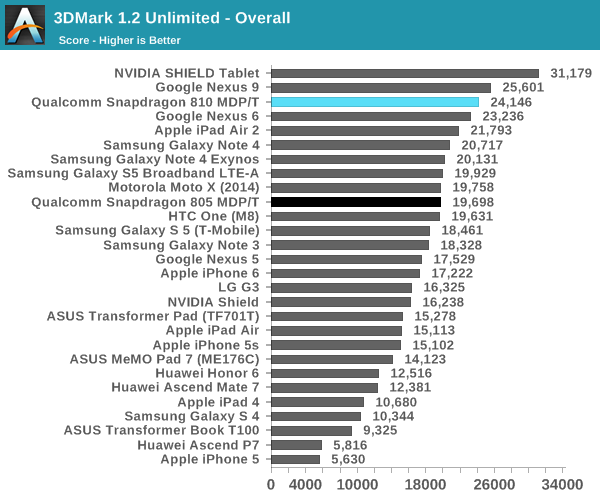
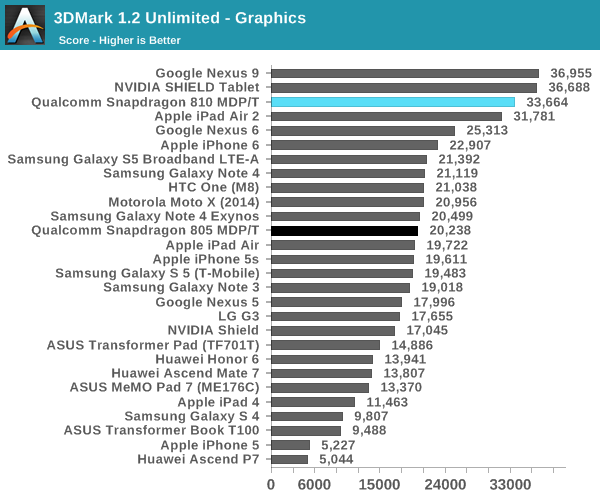
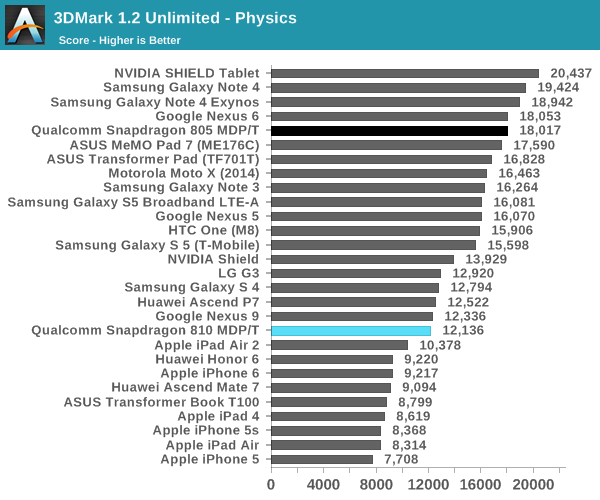
Starting off with 3DMark, compared to the Snapdragon 805 reference platform the actual graphics performance advantage is even greater than 30%, coming in at closer to 65%. However since drivers play a big role in this, a more recent 805 platform like the Nexus 6 may be a better comparison point, in which case the gains are 33%, just a hair over Qualcomm's own baseline performance estimate. We also find that Snapdragon 810 oddly struggles at physics performance here, underperforming Snapdragon 805 devices, something the Exynos 5433 didn't have trouble with. As a result overall performance is only slightly improved over the Nexus 6.
Continuing with GFXBench, we look at more pure GPU loads. One has to take note that the MDP/T employs a 4K screen resolution, and the on-screen results will likely suffer from that.

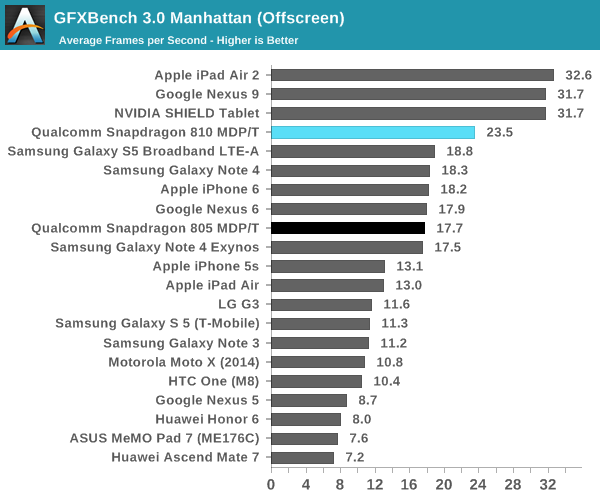
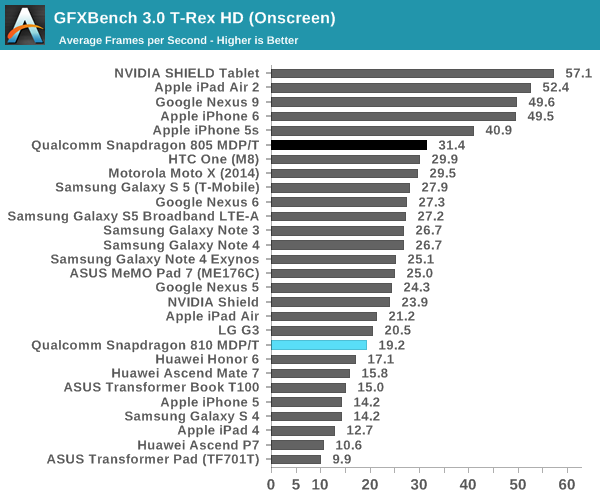

Under GFXBench 3.0's full rendering tests of Manhattan and T-Rex, the Snapdragon 810 continues to show considerable performance gains over the Snapdragon 805. Ignoring the onscreen results for now since the Snapdragon 810 reference platform runs at such a high resolution, offscreen results show the 810 outperforming the 805 by 33% in Manhattan and 16% in T-Rex. The former is again well in-line with Qualcomm's performance estimate, wile the older T-Rex benchmark doesn't show the same gains, possibly indicating that Adreno 430's biggest gains are going to come from shader-bound scenarios.
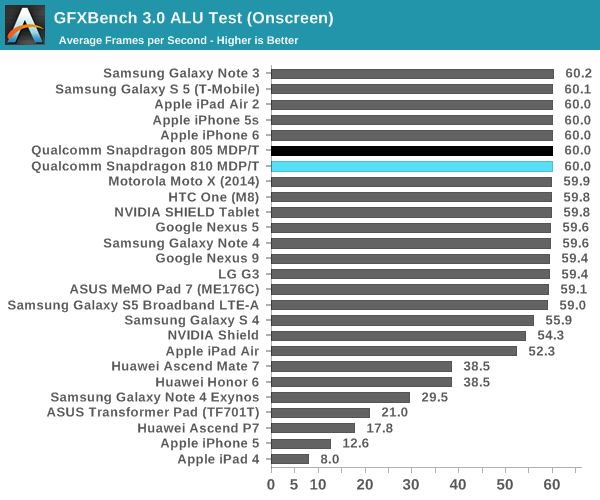
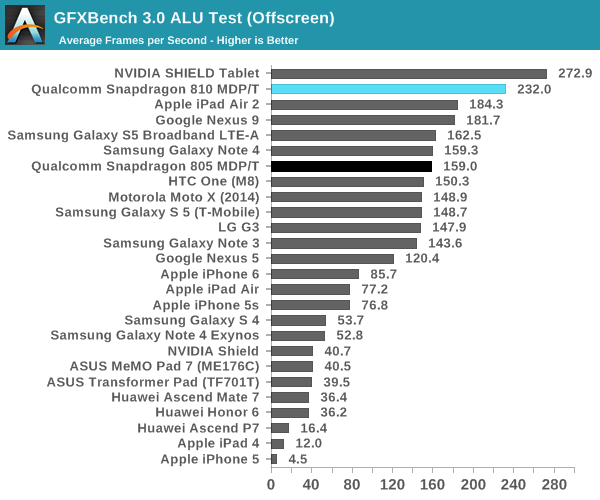
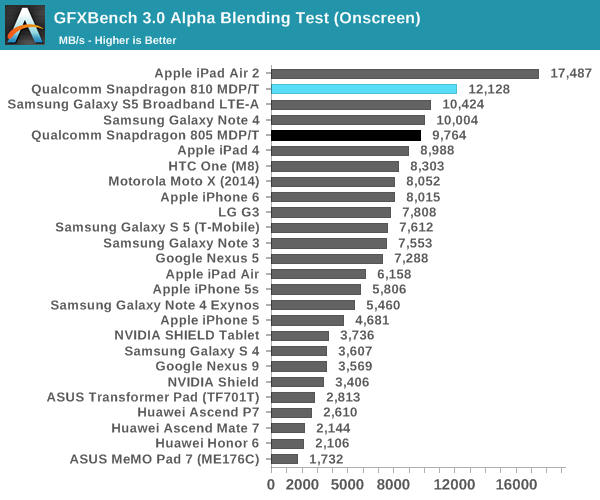
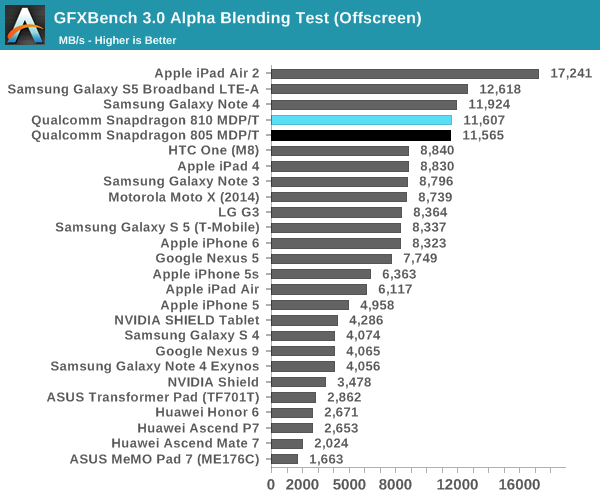
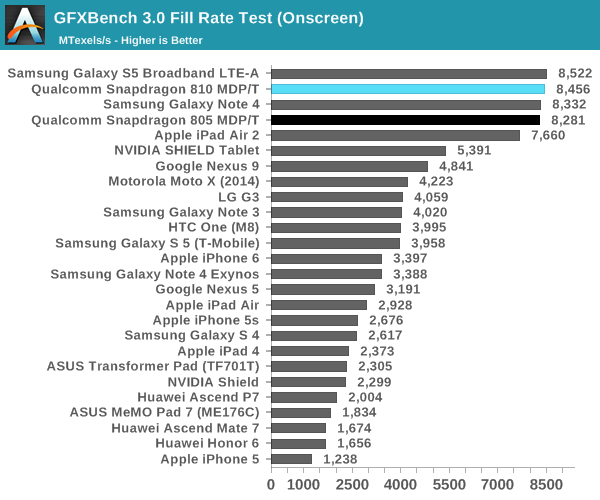
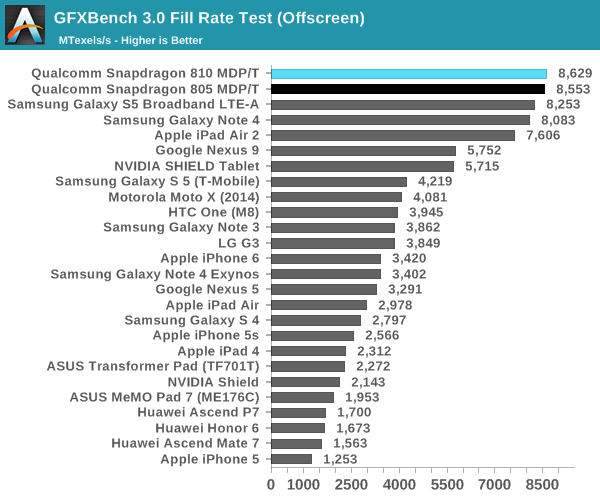
Meanwhile GFXBench's synthetic tests continue to put Adreno 430 and the Snapdragon 810 in a good light. ALU performance in particular is showing very large gains - 46% better than the Snapdragon 805 and Adreno 420 - while our blending and fillrate tests show almost no gain over Snapdragon 805. This adds further credence to our theory that Qualcomm has widened or otherwise improved Adreno's shader blocks for 430, as other elements of the GPU are not showing significant performance changes.
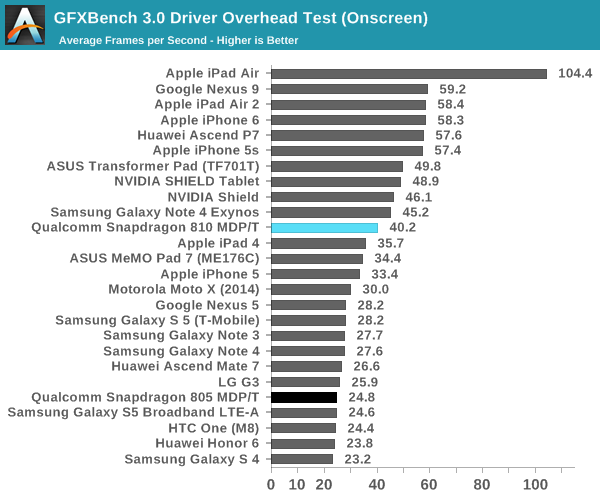
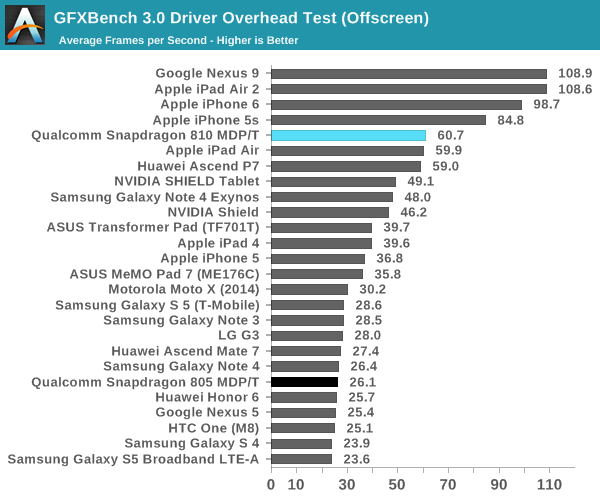
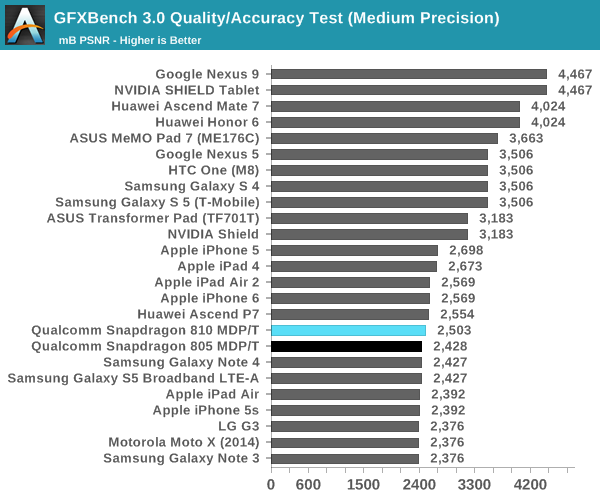

Finally, GFXBench's driver overhead and accuracy tests are more or less what we would expect for Snapdragon 810. In the case of driver overhead, a combination of newer drivers and a much faster CPU have reduced the CPU cost of driver overhead. Meanwhile with the underlying GPU architecture being unchanged, there are no material changes to quality/accuracy.
Overall then the performance gains for the Adreno 430 and Snapdragon 810 seem to be almost exclusively focused on shader performance, but in those cases where rendering workloads are shader bound, Qualcomm's 30% estimate is on the mark. Real-word performance gains meanwhile are going to depend on the nature of the workload; games and applications that are similarly shader-bound should see good performance gains, while anything that's bottlenecked by pixel throughput, texturing, or front-end performance will see much smaller gains. Thankfully for Qualcomm most high-end workloads are indeed shader bound, and this is especially the case when pushing high resolutions, as Qualcomm is trying to do with their 4K initiative for Snapdragon 810. However in the case of 4K, while Adreno 430 offers improved performance it's still slow enough that it's going to struggle to render any kind of decently complex content at that resolution.
As for Adreno 430 versus the competition, Qualcomm has narrowed much of the gap between themselves and NVIDIA/Apple, but they haven't closed it. Apple's Imagination GX6850 and NVIDIA's K1 GPUs continue to hold a performance advantage, particularly in GFXBench's Manhattan and T-Rex full rendering tests. Both Apple and NVIDIA invested significant die space in graphics, and while we don't know how much Qualcomm has invested in Adreno 430 with Snapdragon 810, it's safe to say right now that they would need to invest even more if they want to beat the graphics performance of NVIDIA and Apple's tablet SoCs.










119 Comments
View All Comments
twizzlebizzle22 - Thursday, February 12, 2015 - link
The speed on modern/flagship SoCs are phenomenal. The right implementation and power savings are what I'm focussed on this year.ddriver - Thursday, February 12, 2015 - link
Either there is a typo in the "PNG Comp ST" test, or Exynos 5433 is ~1000 times faster than the competition...MrCommunistGen - Thursday, February 12, 2015 - link
Probably a comma instead of a decimal point. You'll see that the Multithreaded PNG score for the Exynos 5433 is roughly in line with the other SoCs and much "lower" than the Single Threaded score.Mondozai - Thursday, February 12, 2015 - link
"The speed on modern/flagship SoCs are phenomenal."Yes, but not this chip. It's going to be Qualcomm's main chip in 2015, it's still getting beaten by year old tech. Then again, the OEMs want a "total solution" and while Nvidia is crushing them in the GPU benchmarks, Nvidia still doesn't have a good integrated LTE solution, for example.
Nevertheless, GPU power matters. This SoC will struggle with 4K and its supposed to be the high-end. Disappointing.
Makaveli - Thursday, February 12, 2015 - link
Does 4k really matter that much on a 5' display?fokka - Thursday, February 12, 2015 - link
i say no, but sadly that is where the market will go, especially onphablets and tablets. there already are rumours about an lg g4 with a 1800p screen and as we see on qualcomm's reference platform, i'm pretty sure we'll see some 4k tablets enter the market pretty soon.Frenetic Pony - Friday, February 13, 2015 - link
Then don't buy their bullshit, that's easy enough. Anything beyond 1080 for subs 6" is ridiculous and wasteful.Uplink10 - Friday, February 13, 2015 - link
I think anything beyond HD for a smartphone is worthless, difference is not worth the price and energy. Do people need 4K, FullHD, QHD screens because they edit photos and videos on their smartphone which we then see in the cinemas?xnay - Saturday, February 14, 2015 - link
I totally agree with you. And I'm waiting impatiently for the new HTC M9 because it's said to be using 1080p display.Laststop311 - Friday, February 20, 2015 - link
Im with you. I wish they woul stick to standard full HD and focus on improving reflectance of outside light to a lower percentage (better performance in this area is critical it allows easier viewing in sunlight without having to crank the brightness up and use more power), Luminance per watt for either brighter screen or same brightness but less power (which is easily possible if they quit using smaller pixels that block more of the backlight), better color accuracy and gamma with even a higher bit screen to display more color while keeping accuracy high. Pre calibrated with professional tools at the factory the way dell does with their high end u3014.Almost 100% of people I know would trade a couple extra hours of battery life to have less pixels. Less pixels = less power used by gpu, lower power backlight needed, less heat from backlight generated, smaller backlight needed (can make phone a bit thinner), more responsive phone when scrolling less pixels have to be renedered for the scroll animation so it's smoother and faster and uses less energy. And there isn't really a downside. You would have to have super human eagle eyes to see this difference between 1080 RGB strip and 1440 RGB stripe. Many more benefits sticking with 1080. Anything higher is utterly ridiculous for a 5-6 inch phone.
I could honestly get by with 1280 x 720 or 1366 x x756 or whatever it is. I loved the screen on my 5.5" galaxy note 2 with RGB stripe 1280x720 AMOLED. Everything looked plenty crisp and switching to the note 4 sure things do look a bit more crisp but just imagine the battery life saved if it was 1280x720. Bet hours would be added to it.